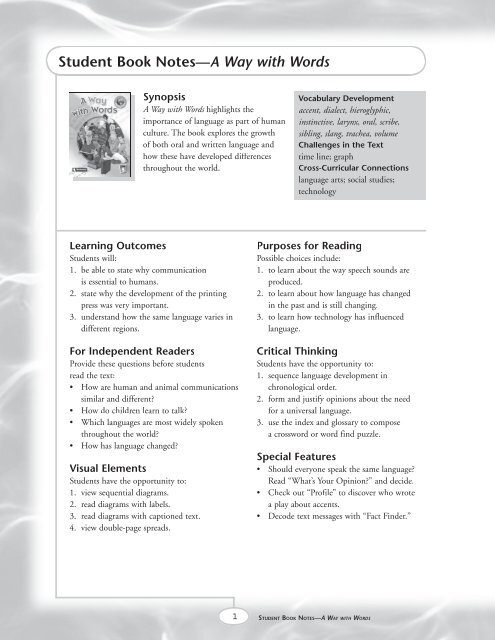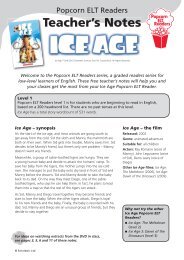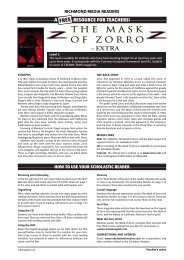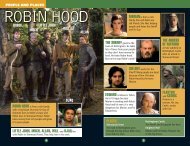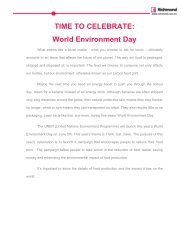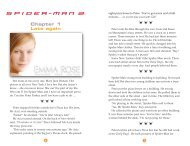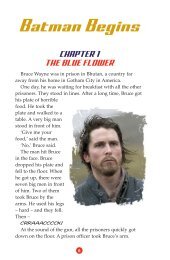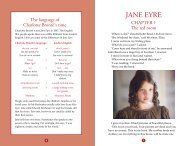Teacher Notes x 16 n5.indd - Richmond
Teacher Notes x 16 n5.indd - Richmond
Teacher Notes x 16 n5.indd - Richmond
Create successful ePaper yourself
Turn your PDF publications into a flip-book with our unique Google optimized e-Paper software.
Student Book <strong>Notes</strong>—A Way with Words<br />
Synopsis<br />
A Way with Words highlights the<br />
importance of language as part of human<br />
culture. The book explores the growth<br />
of both oral and written language and<br />
how these have developed differences<br />
throughout the world.<br />
Vocabulary Development<br />
accent, dialect, hieroglyphic,<br />
instinctive, larynx, oral, scribe,<br />
sibling, slang, trachea, volume<br />
Challenges in the Text<br />
time line; graph<br />
Cross-Curricular Connections<br />
language arts; social studies;<br />
technology<br />
Learning Outcomes<br />
Students will:<br />
1. be able to state why communication<br />
is essential to humans.<br />
2. state why the development of the printing<br />
press was very important.<br />
3. understand how the same language varies in<br />
different regions.<br />
For Independent Readers<br />
Provide these questions before students<br />
read the text:<br />
• How are human and animal communications<br />
similar and different?<br />
• How do children learn to talk?<br />
• Which languages are most widely spoken<br />
throughout the world?<br />
• How has language changed?<br />
Visual Elements<br />
Students have the opportunity to:<br />
1. view sequential diagrams.<br />
2. read diagrams with labels.<br />
3. read diagrams with captioned text.<br />
4. view double-page spreads.<br />
Purposes for Reading<br />
Possible choices include:<br />
1. to learn about the way speech sounds are<br />
produced.<br />
2. to learn about how language has changed<br />
in the past and is still changing.<br />
3. to learn how technology has influenced<br />
language.<br />
Critical Thinking<br />
Students have the opportunity to:<br />
1. sequence language development in<br />
chronological order.<br />
2. form and justify opinions about the need<br />
for a universal language.<br />
3. use the index and glossary to compose<br />
a crossword or word find puzzle.<br />
Special Features<br />
• Should everyone speak the same language?<br />
Read “What’s Your Opinion?” and decide.<br />
• Check out “Profile” to discover who wrote<br />
a play about accents.<br />
• Decode text messages with “Fact Finder.”<br />
STUDENT BOOK NOTES—A WAY WITH WORDS
Guiding Learning<br />
Before Reading<br />
Discuss some colloquial language that students use.<br />
Take an example like “awesome.” e Ask, What would<br />
your parents have said? Make a list of responses ( cool,<br />
groovy, etc.) Then have students discuss why they<br />
think language changes.<br />
During Reading<br />
Key text to guide:<br />
Pages 4–5: Read aloud and then highlight<br />
differences between animal and human<br />
communications. Point out the English word Hello,<br />
and have students find and comment on the other<br />
greetings as the reading progresses. (The greetings<br />
are: p. 7 Thai; p. 9 Spanish; p. 11 Maori; p. 13<br />
Esperanto; p. 15 Kiswahili (Swahili); p. <strong>16</strong> French;<br />
p. 19 Afrikaans; p. 20 Mandarin; p. 22 Italian;<br />
p. 25 Hebrew; p. 29 Hindi)<br />
Pages 6–7: Share read. Help students understand<br />
the diagram and the roles of the larynx, vocal cords,<br />
and trachea.<br />
Pages 8–9: Have students read the body text before<br />
share reading the time line. Ask probing questions<br />
to establish students’ understanding of the order<br />
of development.<br />
Pages 24–27: Say, How was your name chosen? Who<br />
chose it? After students have responded, have them<br />
read independently. Discuss the different ways<br />
children are named throughout the world.<br />
Pages 28–29: Read these pages aloud as there is fun<br />
solving the riddles. Allow time for student pairs to<br />
write word staircases.<br />
After Reading<br />
Responding: Have students discuss what they have<br />
learned about language changes. Ask, How might<br />
language change in the future? Have them justify<br />
their responses.<br />
Thinking Activity Master 1<br />
A Puzzler: Using an Index and a Glossary<br />
Demonstrate beginning a word find and a<br />
crossword puzzle by using the index or glossary.<br />
Discuss conventions involved, including “across<br />
and down” clues. Then students can compose<br />
a crossword puzzle or a simpler word find puzzle<br />
by using the book. Students can trade to complete<br />
a puzzler.<br />
Pages 10–15: Have students read independently.<br />
When finished, discuss the graph on page 11.<br />
Then ask, Do you think there should be only one<br />
world language? Challenge students to justify their<br />
opinions.<br />
Pages <strong>16</strong>–23: Say, Language is always changing.<br />
Read to the end of page 23 to find out how and why<br />
language has changed. (Share read with students<br />
needing support.) When students have finished,<br />
discuss what they have found out. Help them<br />
understand the diagram on page 19 and why<br />
the invention of the printing press was highly<br />
important. Then have students interpret the text<br />
messages on page 23.<br />
STUDENT BOOK NOTES—A WAY WITH WORDS
A Puzzler<br />
Name _______________________________________<br />
Date __________________________<br />
Use the index and glossary in A Way with Words to find information and create a crossword<br />
or word find puzzle. Then trade this sheet to solve someone’s puzzler.<br />
Clues ACROSS<br />
__________________________________<br />
__________________________________<br />
__________________________________<br />
__________________________________<br />
__________________________________<br />
__________________________________<br />
Clues DOWN<br />
________________________________<br />
________________________________<br />
________________________________<br />
________________________________<br />
________________________________<br />
________________________________<br />
THINKING ACTIVITY MASTER 1: USING AN INDEX AND A GLOSSARY—A WAY WITH WORDS
Nonfiction Assessment Record<br />
Book Title: A Way with Words<br />
Student _______________________________________<br />
Date __________________________<br />
Say, Read pages 4 and 5 silently.<br />
Ask, Why is communication very important to<br />
humans?<br />
Did the student understand how much<br />
we rely on communication in a variety<br />
of forms? (Learning Outcome 1)<br />
Say, Read pages 6 and 7 silently.<br />
Ask, What does the larynx do to help us<br />
produce sounds?<br />
Did the student display an understanding<br />
of the role of the larynx?<br />
(Purpose for Reading 1)<br />
Say, Read the time line on pages 8 and 9.<br />
Ask, Can you put the following child’s<br />
language development events into the correct<br />
order? short sentences; 1,000 words; some<br />
nouns<br />
Was the student able to use the language<br />
development time line to correctly<br />
sequence these events?<br />
(Critical Thinking 1)<br />
Say, Read pages 12 through 15 silently.<br />
Ask, Do you think there should be only one<br />
world language? Why/Why not?<br />
Ask, Why does the speech of some people from<br />
different regions who speak the same language<br />
sound quite different?<br />
Was the student able to form and<br />
justify an appropriate opinion?<br />
(Critical Thinking 2)<br />
Did the student understand the<br />
influences of dialect and accent?<br />
(Learning Outcome 3)<br />
Say, Read pages <strong>16</strong> through 19 silently.<br />
Ask, If you traveled back 1,000 years, why<br />
would communication be difficult?<br />
Ask, Why was the development of the printing<br />
press very important?<br />
Did the student display an understanding<br />
of the changing nature of language?<br />
(Purpose for Reading 2)<br />
Could the student form an appropriate<br />
generalization? (Learning Outcome 1)<br />
Say, Read pages 22 and 23 silently.<br />
Ask, How has technology changed written<br />
language?<br />
Did the student mention “shortening<br />
of words” or something similar?<br />
(Purpose for Reading 3)<br />
NONFICTION ASSESSMENT RECORD—A WAY WITH WORDS


